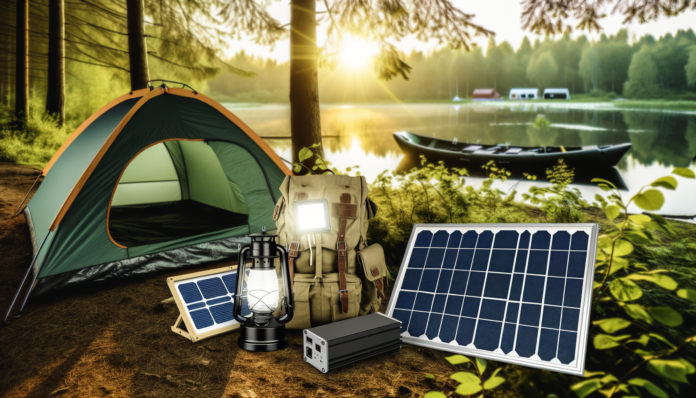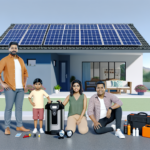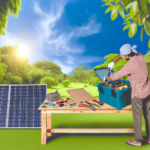Introduction to Solar Gear for Outdoor Enthusiasts
The Growing Popularity of Solar Power
In recent years, solar power has seen a significant surge in popularity, driven by advancements in technology and a growing awareness of environmental sustainability. Solar energy is a clean, renewable resource that reduces our reliance on fossil fuels and minimizes our carbon footprint. For outdoor enthusiasts, the appeal of solar power is particularly strong. It offers a reliable and eco-friendly way to stay connected and powered up, even in the most remote locations. Whether you’re camping, hiking, or embarking on an off-grid adventure, solar gear provides the freedom to explore without sacrificing the comforts of modern technology.
Why Solar Gear is Essential for Outdoor Activities
For those who love spending time in nature, having access to reliable power can be a game-changer. Solar gear is essential for several reasons:
- Independence from Traditional Power Sources: Solar gear allows you to generate your own power, eliminating the need for heavy batteries or noisy generators.
- Environmental Impact: Using solar power reduces your carbon footprint, helping to preserve the natural beauty of the places you love to explore.
- Safety and Convenience: Solar-powered lights, chargers, and appliances ensure you have the necessary tools to stay safe and comfortable, whether you’re navigating a trail at night or cooking a meal at your campsite.
- Cost-Effectiveness: While the initial investment in solar gear can be higher, the long-term savings on fuel and batteries make it a cost-effective solution for frequent adventurers.
Purpose and Scope of This Article
The purpose of this article is to provide outdoor enthusiasts with a comprehensive guide to the best solar gear available on the market. We will explore various types of solar equipment, from panels and chargers to lights and appliances, and review their key features and performance. Our goal is to help you make informed decisions about the solar gear that best suits your needs, ensuring you have the power to enhance your outdoor experiences.
In the following sections, we will delve into the different types of solar gear, highlight the key features to look for, and provide in-depth reviews of top products. We will also offer tips on maintaining and caring for your solar equipment, share real-life applications and success stories, and discuss future trends in solar technology. By the end of this article, you’ll have a thorough understanding of how to harness the power of the sun to elevate your outdoor adventures.
Types of Solar Gear
Solar Panels
Solar panels are the cornerstone of any solar-powered setup for outdoor enthusiasts. These devices convert sunlight into electricity, providing a renewable and eco-friendly energy source. There are several types of solar panels to consider:
- Monocrystalline Panels: Known for their high efficiency and longevity, these panels are made from a single crystal structure. They are ideal for those who need maximum power output in a limited space.
- Polycrystalline Panels: These are made from multiple silicon crystals and are generally less efficient than monocrystalline panels but are more affordable.
- Thin-Film Panels: Lightweight and flexible, these panels are perfect for irregular surfaces and portable applications. However, they are less efficient and have a shorter lifespan compared to crystalline panels.
When choosing a solar panel, consider factors like power output, efficiency, and the type of activities you’ll be engaging in. For instance, a 100-watt monocrystalline panel can produce around 30-amp hours per day, making it suitable for charging small devices and running low-power appliances.
Solar Chargers
Solar chargers are portable devices designed to charge batteries and electronic gadgets directly from the sun. They are essential for keeping your devices powered during outdoor activities like hiking, camping, and boating. Here are some popular types:
- Portable Solar Chargers: These are compact and lightweight, making them easy to carry in a backpack. They are perfect for charging smartphones, GPS devices, and cameras.
- Foldable Solar Chargers: These chargers can be folded into a smaller size for easy transport and unfolded to capture more sunlight. They are ideal for extended trips where you need to charge multiple devices.
- Solar Power Banks: These combine a solar panel with a built-in battery, allowing you to store energy for later use. They are convenient for cloudy days or nighttime use.
When selecting a solar charger, look for features like multiple USB ports, fast charging capabilities, and weather resistance to ensure it meets your needs.
Solar-Powered Lights
Solar-powered lights are a must-have for any outdoor enthusiast. They provide illumination without the need for batteries or electrical outlets, making them perfect for camping, hiking, and emergency situations. Types of solar-powered lights include:
- Solar Lanterns: These are portable and can be hung inside tents or around campsites. They often come with adjustable brightness settings and can last for several hours on a single charge.
- Solar String Lights: Ideal for creating a cozy atmosphere, these lights can be strung around trees, tents, or RVs. They are usually waterproof and come with various lighting modes.
- Solar Headlamps: These are perfect for hands-free lighting during nighttime activities. They are lightweight and often come with adjustable straps and multiple light settings.
When choosing solar-powered lights, consider factors like brightness, battery life, and durability to ensure they can withstand outdoor conditions.
Solar-Powered Appliances
For those who want to bring the comforts of home to the great outdoors, solar-powered appliances are the way to go. These devices can run on solar energy, making them perfect for off-grid living and extended camping trips. Some popular solar-powered appliances include:
- Solar-Powered Refrigerators: These are essential for keeping food and drinks cold without relying on ice or electricity. They are highly efficient and can run on solar panels or solar generators.
- Solar Ovens: These use the sun’s energy to cook food, making them perfect for eco-friendly outdoor cooking. They are portable and can reach high temperatures for baking, roasting, and boiling.
- Solar Showers: These portable devices heat water using solar energy, providing a convenient way to stay clean during camping trips. They are easy to set up and can hold several gallons of water.
When selecting solar-powered appliances, consider their energy consumption, size, and compatibility with your existing solar setup to ensure they meet your needs.
Key Features to Look for in Solar Gear
Portability and Weight
When venturing into the great outdoors, the portability and weight of your solar gear are crucial factors. Lightweight and compact solar panels, chargers, and lights are easier to carry and set up, making them ideal for activities like hiking, camping, and backpacking. Look for foldable or rollable solar panels that can be easily stowed in a backpack. For instance, the Nomad series of solar panels is known for its lightweight and foldable design, making it a favorite among backpackers and campers. Additionally, consider the weight of any batteries or power stations you plan to bring along. Lithium-ion batteries, while more expensive, offer a significant weight reduction compared to traditional lead-acid batteries, making them a smart choice for mobile setups.
Durability and Weather Resistance
Outdoor environments can be harsh, so your solar gear must be durable and weather-resistant. Look for solar panels with robust construction, such as those with anodized aluminum frames and tempered glass covers, like the Boulder series, which are designed to withstand the elements. Ensure that your solar chargers and lights are rated for water and dust resistance, typically indicated by an IP (Ingress Protection) rating. For example, an IP67 rating means the device is dust-tight and can withstand immersion in water up to 1 meter deep. Durability also extends to the connectors and cables, which should be rugged enough to handle frequent use and exposure to the elements.
Efficiency and Power Output
The efficiency and power output of your solar gear determine how quickly and effectively you can charge your devices. Solar panels are rated by their wattage, with higher wattage panels generating more power. Monocrystalline panels, such as those in the Ranger series, are known for their high efficiency and power output, making them suitable for a variety of environmental conditions. When selecting a solar charger, consider its output capacity in relation to your devices’ power requirements. For instance, a 100-watt solar panel can produce around 30-amp hours per day, which is sufficient for charging small devices like smartphones and cameras. Additionally, look for solar gear with Maximum Power Point Tracking (MPPT) technology, which optimizes the power output by adjusting the electrical operating point of the modules.
Ease of Use and Setup
Ease of use and setup are essential for ensuring that you can quickly deploy your solar gear and start harnessing the sun’s energy. Look for solar panels with integrated kickstands or mounting options that allow you to easily position them for maximum sunlight exposure. User-friendly interfaces, such as those found in the Nomad series, make it simple to connect and monitor your devices. Solar chargers with multiple output ports, including USB and DC, provide versatility in charging different types of devices simultaneously. Additionally, consider gear that comes with clear instructions and minimal assembly requirements, so you can spend more time enjoying your outdoor activities and less time troubleshooting your equipment.
In summary, when selecting solar gear for outdoor adventures, prioritize portability and weight, durability and weather resistance, efficiency and power output, and ease of use and setup. By focusing on these key features, you can ensure that your solar gear will be reliable, effective, and convenient, allowing you to make the most of your time in nature.
In-Depth Reviews of Top Solar Gear
Review of Solar Panels
Solar panels are the backbone of any solar-powered setup, converting sunlight into usable electricity. For outdoor enthusiasts, portability and efficiency are key factors. The **Renogy 100W Monocrystalline Solar Panel** is a standout, offering high efficiency and durability. Its compact design makes it easy to transport, and it performs well even in low-light conditions. Another excellent option is the **Jackery SolarSaga 100**, known for its lightweight and foldable design, making it perfect for camping and hiking. It includes multiple USB ports, allowing you to charge several devices simultaneously.
Review of Solar Chargers
Solar chargers are essential for keeping your devices powered on the go. The **Anker 21W Solar Charger** is highly recommended for its high conversion efficiency and fast charging capabilities. It’s lightweight and compact, making it ideal for backpacking trips. The **BigBlue 28W Solar Charger** is another top pick, featuring three USB ports and a built-in ammeter to monitor the charging current. Its foldable design and waterproof material make it a reliable choice for outdoor use.
Review of Solar-Powered Lights
Solar-powered lights are a practical addition to any outdoor adventure, providing illumination without the need for batteries. The **LITOM Solar Landscape Spotlights** are highly rated for their brightness and durability. They offer multiple lighting modes and are weather-resistant, making them suitable for various outdoor conditions. The **URPOWER Solar Lights** are another great option, known for their easy installation and automatic operation. They provide ample light for pathways and campsites, ensuring safety and convenience.
Review of Solar-Powered Appliances
Solar-powered appliances can significantly enhance your outdoor experience by providing the comforts of home. The **Goal Zero Yeti 400 Portable Power Station** is a versatile and powerful option, capable of running small appliances like mini-fridges and fans. It can be recharged via solar panels, making it perfect for extended trips. The **BioLite SolarHome 620** is another innovative product, offering a complete off-grid solar lighting and power system. It includes a solar panel, control box, lights, and a USB charger, providing a comprehensive solution for off-grid living.
In summary, the right solar gear can make a significant difference in your outdoor adventures. Whether you need reliable power for your devices, efficient lighting, or the ability to run small appliances, there are high-quality solar products available to meet your needs.
How to Maintain and Care for Your Solar Gear
Cleaning and Storage Tips
Proper maintenance of your solar gear is essential to ensure its longevity and optimal performance. Here are some key tips for cleaning and storing your solar equipment:
- Regular Cleaning: Dust, dirt, and debris can accumulate on solar panels, reducing their efficiency. Clean the panels with a soft cloth and mild soapy water. Avoid using abrasive materials that could scratch the surface.
- Check for Damage: Inspect your solar gear regularly for any signs of wear and tear, such as cracks or loose connections. Address any issues promptly to prevent further damage.
- Proper Storage: When not in use, store your solar gear in a cool, dry place. Ensure that the storage area is free from moisture and extreme temperatures, which can damage the equipment.
- Protective Covers: Use protective covers for your solar panels and other gear to shield them from dust and physical damage when stored or transported.
Troubleshooting Common Issues
Even with proper care, you may encounter some common issues with your solar gear. Here are a few troubleshooting tips:
- Low Power Output: If your solar panels are not generating enough power, check for obstructions like dirt or shadows. Ensure the panels are positioned correctly to receive maximum sunlight.
- Battery Not Charging: If your solar charger is not charging the battery, inspect the connections and cables for any damage. Ensure that the battery is compatible with the charger and that it is not already fully charged.
- Device Not Powering On: If a solar-powered device is not turning on, check the battery level and ensure it is properly connected. If the problem persists, try resetting the device or consult the manufacturer’s manual for specific troubleshooting steps.
Maximizing the Lifespan of Your Solar Gear
To get the most out of your investment in solar gear, follow these best practices to maximize its lifespan:
- Regular Maintenance: Perform routine checks and maintenance on your solar gear to keep it in good working condition. This includes cleaning, inspecting for damage, and ensuring all connections are secure.
- Optimal Usage: Use your solar gear as intended and avoid overloading it. For example, do not connect devices that exceed the power output capacity of your solar charger or panel.
- Battery Care: For solar-powered devices with rechargeable batteries, follow the manufacturer’s guidelines for charging and discharging. Avoid letting the battery completely drain, and store it in a charged state if not used for extended periods.
- Environmental Considerations: Protect your solar gear from extreme weather conditions. While many solar devices are designed to be weather-resistant, prolonged exposure to harsh elements can still cause damage.
By following these maintenance and care tips, you can ensure that your solar gear remains efficient and reliable for all your outdoor adventures. Proper care not only extends the lifespan of your equipment but also enhances its performance, allowing you to harness the power of the sun effectively.
Real-Life Applications and Success Stories
Camping and Hiking Adventures
For outdoor enthusiasts, solar gear has become a game-changer in camping and hiking adventures. Imagine setting up camp in a remote location and still having the ability to charge your devices, light up your tent, and even cook a meal using solar-powered appliances. **Solar panels** and **solar chargers** are particularly popular among campers and hikers. Lightweight and portable, these devices can be easily attached to backpacks, allowing for continuous charging while on the move.
One notable success story involves a group of hikers who embarked on a month-long trek through the Appalachian Trail. Equipped with foldable solar panels and solar-powered lanterns, they were able to keep their GPS devices, cameras, and phones charged throughout the journey. This not only enhanced their safety but also allowed them to document their adventure without worrying about battery life.
Boating and Marine Use
Solar gear is also making waves in the boating and marine community. Boats often have limited space and weight capacity, making solar power an ideal solution for generating electricity without the need for bulky generators or fuel. **Solar panels** can be installed on the deck or cabin roof, providing a steady supply of power for navigation systems, lights, and even small appliances.
A remarkable example comes from a family who spent an entire summer sailing around the Caribbean. They installed a set of high-efficiency solar panels on their sailboat, which powered everything from their navigation equipment to their refrigerator. This not only reduced their reliance on marinas for power but also allowed them to anchor in secluded bays for extended periods, enjoying the tranquility of nature without sacrificing modern conveniences.
Off-Grid Living
For those who choose to live off the grid, solar gear is not just a convenience but a necessity. Off-grid living requires a reliable and sustainable source of power, and solar energy fits the bill perfectly. **Solar panels**, **solar batteries**, and **solar-powered appliances** can collectively create a self-sufficient energy system that meets all household needs.
Consider the story of a couple who built a tiny home in the mountains, far from the nearest power lines. They installed a comprehensive solar power system, including panels, batteries, and a solar water heater. This setup provided them with all the electricity they needed for lighting, cooking, and even internet access. Their success has inspired many others to consider off-grid living as a viable and sustainable lifestyle choice.
Emergency Preparedness
In times of natural disasters or power outages, solar gear can be a lifesaver. Having a **solar charger** or **solar-powered light** on hand can make a significant difference in emergency situations. These devices are not only portable but also easy to use, making them ideal for quick deployment when traditional power sources are unavailable.
One compelling story involves a community affected by a severe hurricane. With the power grid down for weeks, residents relied on solar-powered lanterns and chargers to stay connected and maintain some level of normalcy. Local authorities distributed solar gear to the most affected areas, which helped in charging phones, providing light, and even powering small medical devices. This experience highlighted the critical role that solar technology can play in emergency preparedness and response.
In conclusion, the versatility and reliability of solar gear make it an invaluable asset for various real-life applications. Whether you’re exploring the wilderness, sailing the seas, living off the grid, or preparing for emergencies, solar technology offers sustainable and efficient solutions to meet your energy needs.
Conclusion and Future Trends in Solar Gear
Summary of Key Points
Throughout this article, we have explored the various types of solar gear available for outdoor enthusiasts, including solar panels, chargers, lights, and appliances. We discussed the essential features to look for, such as portability, durability, efficiency, and ease of use. In-depth reviews of top solar gear provided insights into the best products on the market. Additionally, we covered maintenance tips, real-life applications, and success stories that highlight the practical benefits of solar gear in outdoor activities.
Emerging Technologies in Solar Power
The future of solar gear is bright, with several emerging technologies poised to revolutionize the market:
- Flexible Solar Panels: These panels can be integrated into various outdoor gear, such as backpacks and tents, providing a seamless way to harness solar energy.
- Advanced Energy Storage: Innovations in battery technology are making it possible to store more energy in smaller, lighter packages, enhancing the portability and efficiency of solar gear.
- Wearable Solar Technology: Solar-powered clothing and accessories are becoming more common, allowing outdoor enthusiasts to generate power on the go.
- Smart Solar Devices: Integration with IoT (Internet of Things) is enabling smarter solar gear that can optimize energy usage and provide real-time data on performance and environmental conditions.
These advancements promise to make solar gear more efficient, user-friendly, and versatile, further enhancing the outdoor experience while promoting sustainability.
Final Thoughts and Recommendations
In conclusion, solar gear offers a sustainable and practical solution for outdoor enthusiasts looking to reduce their environmental impact while enjoying the great outdoors. The key to maximizing the benefits of solar gear lies in selecting products that meet your specific needs and ensuring proper maintenance and care.
**Recommendations:**
1. **Invest in Quality:** Choose high-quality solar gear that is durable and efficient. While the initial cost may be higher, the long-term benefits and reliability are worth the investment.
2. **Stay Informed:** Keep up with the latest advancements in solar technology to take advantage of new features and improvements.
3. **Practice Sustainability:** Use solar gear as part of a broader commitment to sustainable outdoor practices, such as minimizing waste and respecting natural habitats.
4. **Educate and Advocate:** Share your knowledge and experiences with others to promote the adoption of solar gear and sustainable outdoor activities.
By embracing solar technology, outdoor enthusiasts can enjoy their adventures while contributing to a healthier planet. The future of solar gear is promising, and its continued development will undoubtedly play a crucial role in shaping sustainable outdoor recreation.






